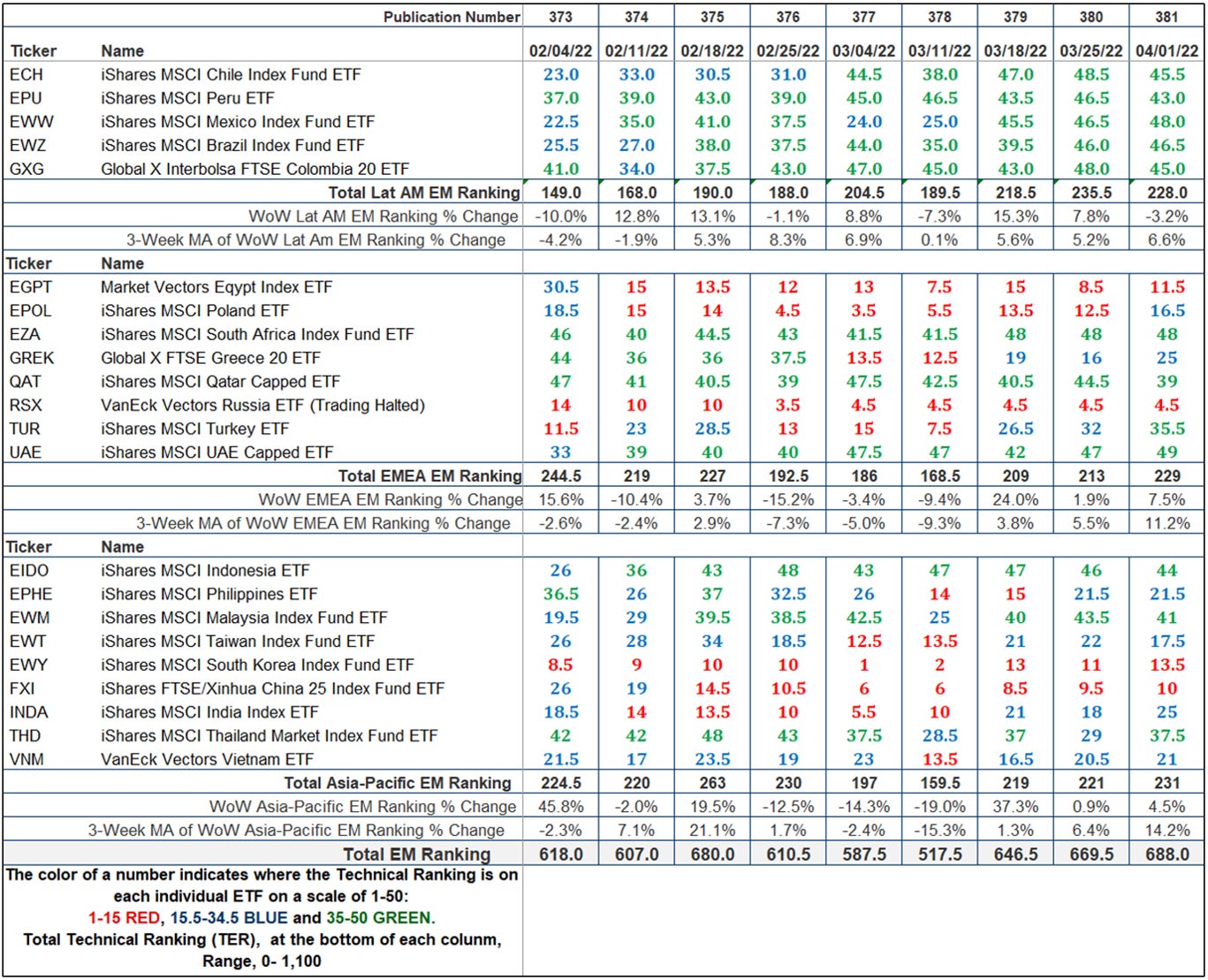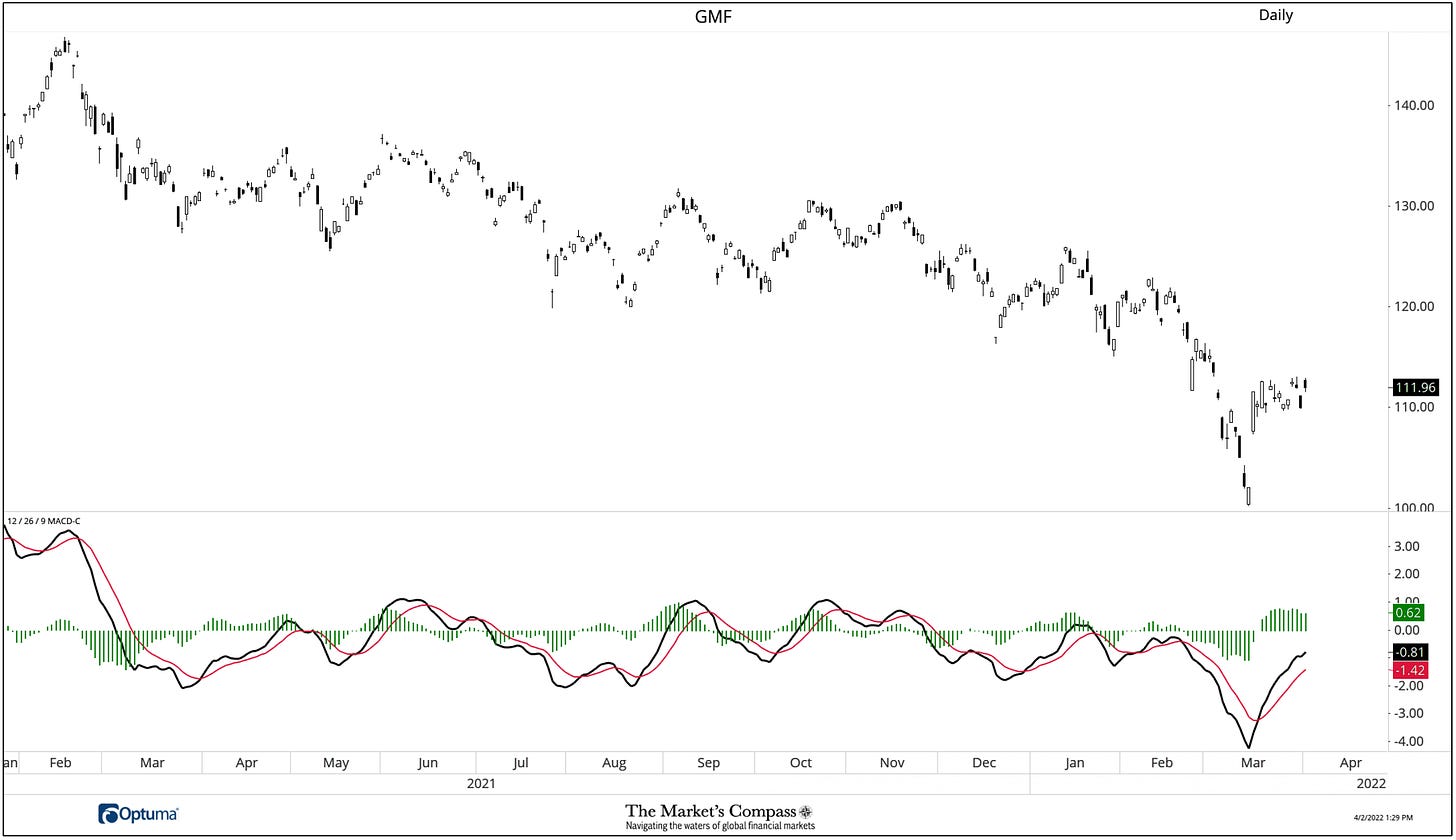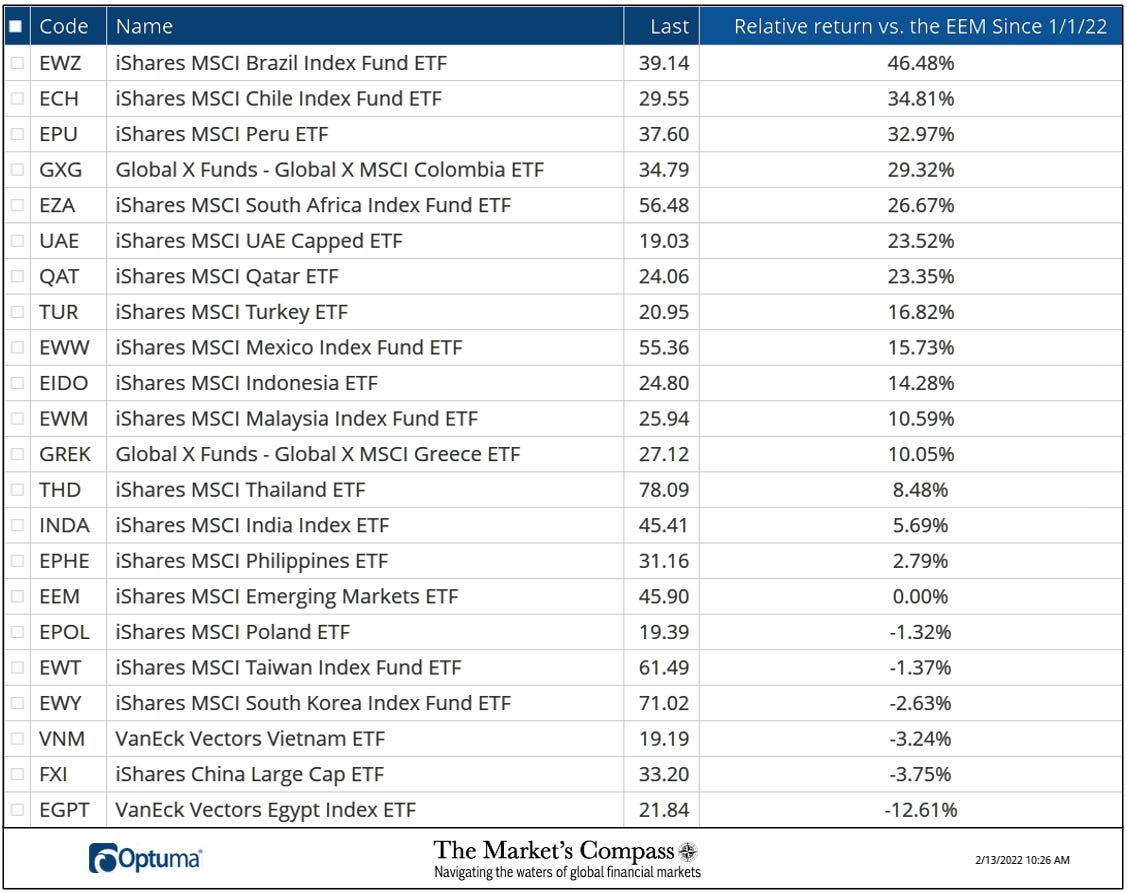This is the third publication of the Market’s Compass Emerging Markets Country ETF Study to be published in our Substack Blog that will highlight the technical changes of the 22 EM ETFs that we track on a weekly basis that also includes notes on the technical changes from our last published Market’s Compass EM Countries ETF Study three weeks ago on March 14th. This is the last Market’s Compass ETF Studies available to free subscribers. Paid subscribers will continue to receive the Weekly ETF Studies sent directly to their registered email. Past publications can be accessed via The Market’s Compass Substack Blog, The Market’s Compass website or by contacting us directly. Please note, due to the travel commitments of the author this week’s ETF study is being published late and prices are as of last Friday.
Last Week’s and 8 Week Trailing Technical Rankings of Individual ETFs
The Excel spreadsheet below indicates the weekly change in the Technical Ranking (“TR”) of each individual ETF. The technical ranking or scoring system is an entirely quantitative approach that utilizes multiple technical considerations that include but are not limited to trend, momentum, measurements of accumulation/distribution and relative strength. If an individual ETFs technical condition improves the Technical Ranking TR rises and conversely if the technical condition continues to deteriorate the TR falls. The TR of each individual ETF ranges from 0 to 50. The primary take away from this spread sheet should be the trend of the individual TRs either the continued improvement or deterioration, as well as a change in direction. Secondarily, a very low ranking can signal an oversold condition and conversely a continued very high number can be viewed as an overbought condition, but with due warning, over sold conditions can continue at apace and overbought securities that have exhibited extraordinary momentum can easily become more overbought. A sustained trend change needs to unfold in the TR for it to be actionable. The TR of each individual ETF in each of the three geographic regions can also reveal comparative relative strength or weakness of the technical condition of the select ETFs in the same region.
As can be seen above, of the three Emerging Market Country regions we track, only the five Latin America Country ETFs have sported Technical Rankings (“TRs”) that have been in the “green zone” (above 35) for the past three weeks. The Total Lat AM EM Ranking hit a high of 235.5 two weeks ago (we highlighted the continued relative outperformance of the 5 Lat Am Country ETFs in our last two EM Blogs. There has been a marked improvement in the Asia-Pacific EM Ranking that includes 9 separate country ETF TRs which has helped lift the Total EM Ranking to 688 from the weekly low of 517.5 on March 11th. The Asia-Pacific Total Ranking has risen to 231 from 159.5 by 71.5 “handles” or 44.8% since that March 11th reading. The SPDR S&P Emerging Asia Pacific ETF (GMF) has recovered from its nadir on March 15th (chart presented below) and although the advance from those lows have slowed in a consolidating price pattern as of late, it is nonetheless up 11.79% from the lows. Note in the lower panel of the chart that MACD has been tracking higher above its signal line reflecting the recent reversal of downside price momentum although it remains in negative territory. The GMF is not a hugely liquid ETF (with a 90-day Average Aggregate Volume of 31,600 shares) but the chart of the ETF serves to represent the initial reversal of the underlying equities in the Asia-Pac region. The page following the chart of the GMF are the top 15 holdings in the ETF and are heavily weighted to Taiwanese, Chinese, and Indian equities facilitated by investments in Depositary Receipts.
The EEM with This Week’s Total ETF Ranking “TER” Overlayed
The Total ETF Ranking (“TER”) Indicator is a total of all 22 ETF rankings and can be looked at as a confirmation/divergence indicator as well as an overbought oversold indicator. As a confirmation/divergence tool: If the broader market as measured by the iShares MSCI Emerging Markets Index ETF (EEM) continues to rally without a commensurate move or higher move in the TE” the continued rally in the EEM Index becomes increasingly in jeopardy. Conversely, if the EEM continues to print lower lows and there is little change or a building improvement in the TER a positive divergence is registered. This is, in a fashion, is like a traditional A/D Line. As an overbought/oversold indicator: The closer the TER gets to the 1100 level (all 22 ETFs having a TR of 50) “things can’t get much better technically” and a growing number individual ETFs have become “stretched” the more of a chance of a pullback in the EEM. On the flip side the closer to an extreme low “things can’t get much worse technically” and a growing number of ETFs are “washed out technically” an oversold rally or measurable low is close to be in place. The 13-week exponential moving average in Red smooths the volatile TER readings and analytically is a better indicator of trend.
The EEM Total Technical Ranking (“TER”) of the 22 Emerging Market Country ETFs rose to 688.0 from 669.5 the previous week, resulting in a +2.76% gain week over week. Over the 3-week period since we last published the Total EM Ranking rose to 688 from 517.5. We remind readers that because a good number EM ETFs are thinly traded and are subject to wide swings, which in turn creates volatile individual Technical Ranking changes, that the calculation of the TER also fluctuates in a similar manor. Analytically, focusing on the 13-week moving average of the TER is a far better indicator. That moving average has not made a new higher high, but it is beginning to trend higher. TER divergences take time to develop, and only if we begin to see price break out of the down trend or the TER decisively break out of the contracting triangle to higher highs would we be prepared to suggest that the EEM may be out of the woods.
Absolute Performance of the 22 Emerging Market Countries ETFs Year to Date*
*Does not include dividends and the RSX which is still not trading.
Additional confirmation of the outperformance on the Lat AM Country ETFs since the start of the year are revealed on the chart above with the iShares MSCI Brazil Index Fund ETF (EWZ +39.44%), the iShares Chile Index Fund ETF (ECH +27.98%) and the iShares MSCI Peru ETF (EPU +26.94%).
The Average “TR” Ranking of the 22 ETFs
The Average Technical Ranking (“ATR”) of the 22 Emerging Markets Country ETFs rose over the past three weeks from a low on the week ending March 11th of 23.52 to 29.39, 30.43, 31.27 respectively, but the trend, as can be seen by the longer-term moving average (blue line) remains flat in a sideways churn although the shorter-term moving average (red line) is beginning to hint at a turn higher. The EEM that was griding lower since February has partially reversed over the past three weeks. Over that period the EEM is up +7.82. That said the ATR has avoided printing a lower low thanks in part by an improvement in Asia Pacific ETF also because of a result of the Lat-Am TRs being elevated, with those removed this week’s ATR reading of the remaining 17 ETFs would be 27.06.
The Week Over Week Change in Technical Rankings*
*The RSX which has an ongoing trading halt has been deleted from his week’s Week over Week changes in the TRs.
The three largest Technical Ranking gains the past week were the Global X FTSE Greece 20 ETF (GREK) rising +9 to 25 from 16 followed by the iShares MSCI Thailand Index Fund ETF (THD) which rose by +8.5 to 37.5 from 29 and the iShares MSCI India Index ETF (INDA) which rose by +7 to 25 from 18. Data is courtesy of Optuma.
The Emerging Markets Country ETFs Weekly Absolute and Relative Price % Change*
*Does not including dividends, the VanEck Vectors Russia ETF (RSX) is again, omitted.
Fifteen of the 22 Emerging Markets Country ETFs we track improved on an absolute basis last week, led by the Global X MSCI Greece 20 ETF (GREK) up +5.20%. Eight EM ETFs outperformed the iShares MSCI Emerging Markets ETF (EEM) on a relative basis which was up 1.89% on the week. On a relative basis 13 EM ETFs underperformed. On the week, the worst performing ETF on an absolute basis and relative basis was the iShares MSCI Qatar ETF down -1.07% and -2.90% respectively. As can been seen on the chart below this was only a pause in what can be classified as a powerful constructive rally from the March 2020 low (the top 15 holdings in the ETF follow the weekly chart below). Data is courtesy of Bloomberg.
QAT Holdings
The Relative Return Vs. the EEM Index Year to Date*
*Does not including dividends or the RSX
I invite our readers to contact me with any questions or comments at…tbrackett@themarketscompass.com













